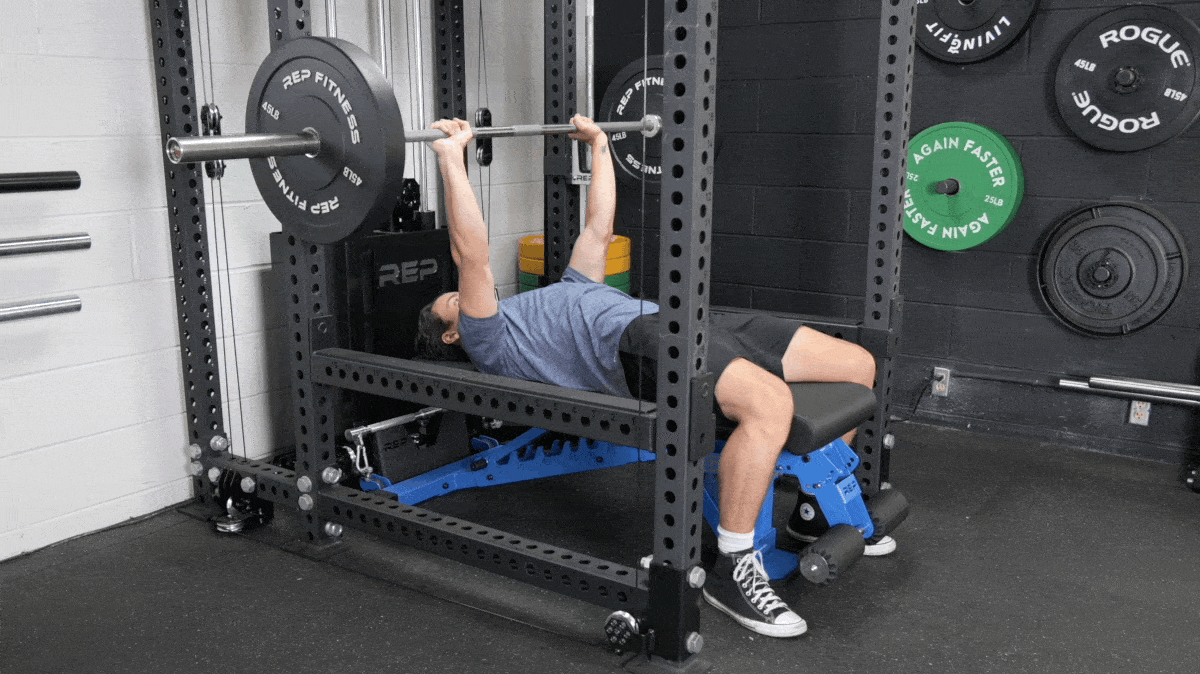“You might have the worst bench press on the planet if you do these three things,” says content creator and coach Jeff Nippard.
We aren’t sold just yet, but we’ll hear what Nippard has to say and then determine whether his fixes will help you increase strength or build muscle.
And don’t worry — you probably don’t have the “worst bench” on Earth if you’re guilty of one or more of these three bench press mistakes. Even if you are, you’re about to learn how to fix them.
- Not touching your chest with the bar
- Letting your spotter do all the work
- Pressing the bar in the wrong direction

1. Not Touching Your Chest
“If you don’t touch your chest with the bar, you’re probably lifting too heavy,” Nippard said on social media on Aug. 15, 2024.
He’s right — ego lifting will get you nowhere fast, but there are other reasons you may not be touching your chest with the bar on the bench press.
- You may have heard that bench pressing is dangerous for your shoulders, but studies show that powerlifters who bench competitively don’t have a high rate of injury compared to most contact sports. (1)
[Related: Best Pre-Workout Supplements for Chest Day]
Nippard argued partial-range-of-motion training is one of the biggest bench press mistakes because, “that’s where most of the muscle growth comes from.”
He’s right; studies tell us that stretching a muscle under load is (probably) optimal for growth, (2) and your pecs experience the biggest stretch in the bottom half of the bench press.
If you have trouble touching your chest when you bench, play around with your grip width and make sure you’re arching your back as well to increase stability in your shoulder girdle.
2. Letting Your Spotter Do the Work
Spotters are invaluable when it comes to safety, but one of the most nefarious bench press mistakes you can make is turning your bench press workouts into a biceps workout for your spotter.
- “If your spotter’s bicep pump is better than your chest pump, they’re doing too much,” Nippard remarked.
Spotters are helpful for motivation and some research has shown that bodybuilders utilize hypertrophy training techniques like forced reps to maximize muscular size. (3)
[Related: Best Supplements for Muscle Growth]
Nippard advised not letting your spotter touch your barbell unless it starts moving down instead of up, and we agree.
You might also want to ask them to stand clear unless they need to spring into action; the gym is a sweaty place after all, and you don’t want anybody standing directly over your face. That’s bad gym etiquette.
3. Pressing in the Wrong Direction
If your bench press bar path moves away from your shoulders, rather than toward them, Nippard thinks you might be leaving gains on the table.
- “If you’re training for max strength, you’ll want to press the bar up and back slightly,” said Nippard.
[Related: Best Wrist Wraps for the Bench Press]
As far as bench press mistakes go, this one might be the most subtle. But it matters — strength researcher Greg Nuckols has discussed the importance of an angular bar path during the bench press to ensure the load is stacked vertically atop the wrist, elbow, and shoulder joints.
Nippard noted that a straight up-and-down bar path is fine too if you’re benching mainly for chest hypertrophy, but you should never push the bar up and away from you.
More Training Content
- Do Different Row Grips Matter?
- The Worst Gym Machines Your Workout Does NOT Need
- How To Make Bodybuilding Gains With the Smith Machine
References
- Dudagoitia Barrio, Ekaitz & Garcia de Alcaraz, Antonio & Andersen, Lars. (2021). Safety of powerlifting: A literature review. Science & Sports. 36. 10.1016/j.scispo.2020.08.003.
- Pedrosa GF, Lima FV, Schoenfeld BJ, Lacerda LT, Simões MG, Pereira MR, Diniz RCR, Chagas MH. Partial range of motion training elicits favorable improvements in muscular adaptations when carried out at long muscle lengths. Eur J Sport Sci. 2022 Aug;22(8):1250-1260. doi: 10.1080/17461391.2021.1927199. Epub 2021 May 23. PMID: 33977835.
- Krzysztofik M, Wilk M, Wojdała G, Gołaś A. Maximizing Muscle Hypertrophy: A Systematic Review of Advanced Resistance Training Techniques and Methods. Int J Environ Res Public Health. 2019 Dec 4;16(24):4897. doi: 10.3390/ijerph16244897. PMID: 31817252; PMCID: PMC6950543.
Featured Image: @jeffnippard / Instagram